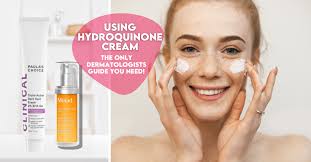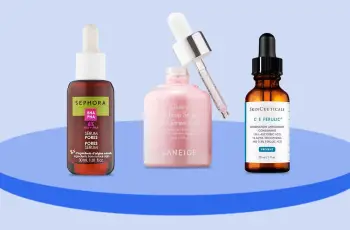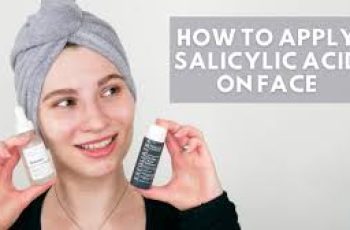
Hydroquinone in Skin Care Products: A Comprehensive Review by a Dermatologist
Hydroquinone is one of the most powerful ingredients used in dermatology to treat stubborn pigmentation issues.
It belongs to a class of compounds called tyrosinase inhibitors, which work by slowing down melanin production—the pigment responsible for skin color and the appearance of dark spots.
Because of its ability to interrupt melanin formation, hydroquinone has become a widely used treatment for lightening unwanted pigmentation and improving overall skin tone when prescribed by dermatologists.
In this comprehensive review, we will explore what hydroquinone is, how it works, its common uses, safety profile, potential side effects, and how to use it correctly under professional guidance.
As a dermatologist, I frequently prescribe hydroquinone for various pigmentation concerns, but I also emphasize that correct use is critical to avoid complications and maximize results.
What Is Hydroquinone Used For?
Hydroquinone is considered the gold standard topical agent for reducing hyperpigmentation.
In the United States, it is the most potent skin-lightening ingredient legally available, though it now requires a prescription for safe and supervised use.
Dermatologists often recommend hydroquinone for conditions such as:
Melasma: A chronic condition characterized by dark, blotchy patches on the face, often worsened by sun exposure or hormonal changes.
Post-inflammatory hyperpigmentation (PIH): Dark marks left behind after acne breakouts, eczema flares, or other skin injuries.
Solar lentigines: Also known as age spots or liver spots, these flat brown spots appear due to cumulative sun exposure over time.
Freckles and uneven skin tone: Hydroquinone can help fade scattered freckles and correct irregular pigmentation across the face or body.
Dyschromias: A general term for abnormal skin pigmentation caused by excessive melanin activity.
Hydroquinone Safety: Clarifying Common Concerns
Although hydroquinone has been widely used for decades, its safety profile has been debated, leading to regulatory changes in some countries.
In 2000, the European Union banned hydroquinone from cosmetic products due to safety concerns.
Similarly, countries such as Japan and South Korea heavily restrict its use, allowing only doctor-prescribed formulations.
In the U.S., hydroquinone was once available over-the-counter in 2% concentrations, but the CARES Act of 2020 reclassified it as prescription-only to ensure proper medical oversight.
This decision was based on the lack of long-term safety data for unsupervised use and the desire to prevent misuse that could lead to complications.
Does Hydroquinone Cause Cancer?
One of the most common fears is that hydroquinone may cause cancer because it is chemically related to benzene, a known carcinogen.
However, it is crucial to differentiate between chemical similarity and actual biological behavior in the human body.
Animal studies where rats ingested very high oral doses of hydroquinone suggested a possible risk, but these findings do not translate directly to topical use in humans.
In humans, hydroquinone is metabolized primarily in the liver into non-toxic compounds such as glucuronides and sulfates, significantly lowering the risk of systemic toxicity.
After more than 40 years of use, there have been no documented cases of cancer directly caused by properly used topical hydroquinone in humans.
While caution and medical guidance are always important, current evidence does not support the belief that topical hydroquinone causes cancer when used as directed.
What Is Exogenous Ochronosis and How Common Is It?
The most serious potential side effect of long-term, unsupervised hydroquinone use is exogenous ochronosis.
This rare but disfiguring condition is characterized by bluish-black discoloration in the treated areas, often developing after extended use of high-concentration hydroquinone.
Ochronosis occurs when hydroquinone disrupts an enzyme called homogentisic acid oxidase, leading to pigment accumulation deep within the skin.
It is more common among individuals with darker skin types (Fitzpatrick Types IV–VI) and those in African, Asian, or Latin American populations.
Fortunately, exogenous ochronosis is extremely rare. In North America, only about 30 documented cases have been reported despite hydroquinone’s widespread use.
This low risk highlights the importance of medical supervision, appropriate strength selection, and avoiding prolonged continuous use without breaks.
Other Common Side Effects of Hydroquinone
Beyond ochronosis, hydroquinone can cause more common but usually mild side effects if misused or used on sensitive skin.
Contact dermatitis: Some individuals develop redness, itching, or rash, often as a result of irritation or allergic reaction to the ingredient.
Skin dryness and irritation: This is particularly likely when hydroquinone is combined with other active ingredients like retinoids or exfoliating acids.
Photosensitivity: Treated areas may become more sensitive to sunlight, increasing the risk of sunburn and rebound pigmentation if sunscreen is not used diligently.
Nail discoloration: In rare cases, hydroquinone can cause the fingernails to develop a brownish tint.
Tips for Reducing Side Effects
To lower your risk of side effects, dermatologists recommend several precautions when starting hydroquinone.
Always apply hydroquinone exactly as prescribed, usually once or twice daily, and never exceed the recommended duration of treatment.
Perform a patch test on a small area first to check for irritation or allergy before using it on larger facial areas.
Take periodic “hydroquinone holidays” every 3–4 months, pausing treatment to allow your skin to recover and prevent complications like ochronosis.
Most importantly, wear a broad-spectrum sunscreen daily because sun exposure can worsen hyperpigmentation and increase photosensitivity during treatment.
How Does Hydroquinone Work to Lighten the Skin?
Hydroquinone reduces pigmentation through several mechanisms, making it a highly effective solution for stubborn discoloration.
It inhibits tyrosinase, a key enzyme required for melanin production, reducing melanin formation by up to 90% in treated areas.
Hydroquinone also exerts a mild cytotoxic effect on melanocytes, the pigment-producing cells, selectively reducing their numbers in the skin.
Additionally, it disrupts DNA and RNA synthesis within melanocytes, further limiting melanin production at the genetic level.
This multi-faceted approach makes hydroquinone more effective than many alternative lightening agents, especially when combined with complementary treatments.
How to Use Hydroquinone Correctly
Hydroquinone may be used as a standalone product or as part of a combination therapy to enhance its results and reduce irritation.
Dermatologists often pair it with tretinoin, a retinoid that increases cell turnover, allowing hydroquinone to penetrate deeper and work faster.
Mild topical corticosteroids are sometimes prescribed alongside hydroquinone to reduce irritation and inflammation that can occur during treatment.
Exfoliating ingredients such as glycolic acid or kojic acid are frequently combined to help remove pigmented cells and boost lightening effects.
A popular combination product is Tri-Luma, which contains hydroquinone, tretinoin, and a corticosteroid, making it ideal for treating melasma.
How Long Does It Take to See Results with Hydroquinone?
Hydroquinone requires consistency and patience. Visible improvement typically appears within 6 to 12 weeks of regular use, though some patients may need several months to achieve optimal results.
Fading pigmentation takes time because melanin production must slow down, and pigmented cells already present must be shed naturally through skin turnover.
If there is no noticeable improvement after 3 months, your dermatologist may suggest adjusting the concentration or exploring alternative therapies.
Where Can You Buy Hydroquinone?
Because hydroquinone is now a prescription-only medication in the U.S., you must see a dermatologist or licensed healthcare provider to obtain it legally.
Prescription creams usually contain 4% hydroquinone, but compounding pharmacies can create customized formulations from 2% up to 10% based on individual needs.
Never buy hydroquinone from unverified online sources, as counterfeit products may contain unsafe ingredients or incorrect concentrations.
Popular Hydroquinone Brands and Formulations
Some common prescription brands that include hydroquinone are:
Alphaquin, Claripel, Eldopaque, Epiquin Micro, Lustra-AF, Melanex, Melquin HP 4%, Solaquin, Tri-Luma (combination formula)
Dermatologists may also work with compounding pharmacies to create custom formulations tailored to your skin type and treatment goals.
Is Hydroquinone a Natural Ingredient?
Hydroquinone can be found in small amounts in certain foods and drinks, including coffee, tea, grains, fruits, vegetables, wine, and beer.
However, the hydroquinone used in topical creams is synthesized in laboratories for consistency and purity, making it a synthetic ingredient rather than a natural one.
Those seeking plant-based or gentler alternatives might consider ingredients like arbutin, licorice root extract, niacinamide, or kojic acid, though they are generally less potent than hydroquinone.
Know Your Skin Type Before Starting Hydroquinone
Understanding your skin type is essential for safely and effectively using hydroquinone or any other skin-lightening agent.
The Baumann Skin Type system is a helpful tool that classifies skin into 16 unique profiles based on four parameters: oiliness, sensitivity, pigmentation, and wrinkling.
Identifying your skin type allows your dermatologist to choose the right hydroquinone concentration and complementary products for maximum results with minimal risk.
Conclusion
Hydroquinone remains one of the most effective dermatological treatments for melasma, dark spots, and other pigmentation disorders when used responsibly under medical supervision.
By understanding how it works, following your dermatologist’s instructions, and being aware of potential risks, you can safely achieve a brighter, more even complexion.
If you are struggling with persistent pigmentation, book a consultation with a qualified dermatologist to discuss whether hydroquinone is the right option for your skin.


